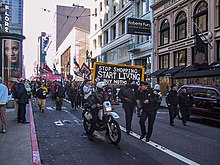Buy Nothing Day: Difference between revisions
Freckletini (talk | contribs) m added internal link to sit-in |
|||
| Line 12: | Line 12: | ||
* Whirl-mart: Participants silently steer their shopping carts around a shopping mall or store in a long, baffling conga line without putting anything in the carts or actually making any purchases. |
* Whirl-mart: Participants silently steer their shopping carts around a shopping mall or store in a long, baffling conga line without putting anything in the carts or actually making any purchases. |
||
* Public protests |
* Public protests |
||
* Wildcat General Strike: |
* Wildcat General Strike: A strategy used for the 2009 Buy Nothing Day where participants not only do not buy anything for twenty-four hours but also keep their lights, televisions, computers and other non-essential appliances turned off, their cars parked, and their phones turned off or unplugged from sunrise to sunset.<ref name="Adbusters BND"/> |
||
* Buy Nothing Day hike: |
* Buy Nothing Day hike: Rather than celebrating consumerism by shopping, participants celebrate the earth and nature.<ref>Buy Nothing Day hike announcement http://www.backtonatives.org/events.htm</ref> |
||
* Buy Nothing [[Critical Mass]]: As the monthly Critical Mass bike ride often falls on this day or near, rides in some cities acknowledge and celebrate Buy Nothing Day. |
|||
==Criticism== |
==Criticism== |
||
Revision as of 19:17, 26 November 2009

Buy Nothing Day (BND) is an international day of protest against consumerism observed by social activists. Typically celebrated the Friday after American Thanksgiving in North America and the following day internationally, in 2009 the dates are November 27 and 28 respectively.[1] It was founded by Vancouver artist Ted Dave and subsequently promoted by Adbusters magazine, based in Canada.
The first Buy Nothing Day was organized in Vancouver in September 1992 "as a day for society to examine the issue of over-consumption."[2] In 1997, it was moved to the Friday after American Thanksgiving, also called "Black Friday", which is one of the 10 busiest shopping days in the United States. Outside North America and Israel, Buy Nothing Day is the following Saturday. Adbusters faced censorship from major television networks and CNN was the only one to air their ads.[3] Soon, campaigns started appearing in United States, the United Kingdom, Israel, Austria, Germany, New Zealand, Japan, the Netherlands, France, and Norway. Participation now includes more than 65 nations.[2]
Buy Nothing Day Activities
Various gatherings, shenanigans, and forms of protest have been used on Buy Nothing Day to draw attention to the issue of over-consumption:
- Credit card cut up: Participants stand in a shopping mall, shopping center, or store with a pair of scissors and a poster that advertises help for people who want to put an end to mounting debt and extortionate interest rates with one simple cut.
- Free, non-commercial street parties
- Sit-ins
- Zombie Walk: Participant ‘zombies’ wander around shopping malls or other consumer havens with a blank stare and marvel at the expressionless faces of the shoppers (their fellow zombies). When asked what they are doing participants describe Buy Nothing Day and explain its foundational principles.
- Whirl-mart: Participants silently steer their shopping carts around a shopping mall or store in a long, baffling conga line without putting anything in the carts or actually making any purchases.
- Public protests
- Wildcat General Strike: A strategy used for the 2009 Buy Nothing Day where participants not only do not buy anything for twenty-four hours but also keep their lights, televisions, computers and other non-essential appliances turned off, their cars parked, and their phones turned off or unplugged from sunrise to sunset.[1]
- Buy Nothing Day hike: Rather than celebrating consumerism by shopping, participants celebrate the earth and nature.[4]
- Buy Nothing Critical Mass: As the monthly Critical Mass bike ride often falls on this day or near, rides in some cities acknowledge and celebrate Buy Nothing Day.
Criticism
While critics of the day charge that Buy Nothing Day simply causes participants to buy the next day,[5] Adbusters states that it "isn't just about changing your habits for one day" but "about starting a lasting lifestyle commitment to consuming less and producing less waste."[2]
Buy Nothing Day has been criticized by some groups as a consumer-oriented empowerment activity that is insulting to those who simply cannot afford to buy anything at all, and that all successful boycotts in the past have been held until there was a gain, not planned for a single day. A group in Montreal promoted "Steal Something Day" as an alternative.[6] In their words, "The geniuses at Adbusters have managed to create the perfect feel-good, liberal, middle-class activist non-happening. A day when the more money you make, the more influence you have (like every other day). A day which, by definition, is insulting to the millions of people worldwide who are too poor or marginalized to be considered 'consumers'."
Related articles
References
- ^ a b "Buy Nothing Day"Adbusters.org
- ^ a b c Buy Nothing Day 2006 press release
- ^ "Buy Nothing Day"The Guardian.co.uk
- ^ Buy Nothing Day hike announcement http://www.backtonatives.org/events.htm
- ^ Why I Shop on Buy Nothing Day, TheTyee.ca, 11/24/2006
- ^ Steal Something Day http://www.urban75.org/archive/news088.html
